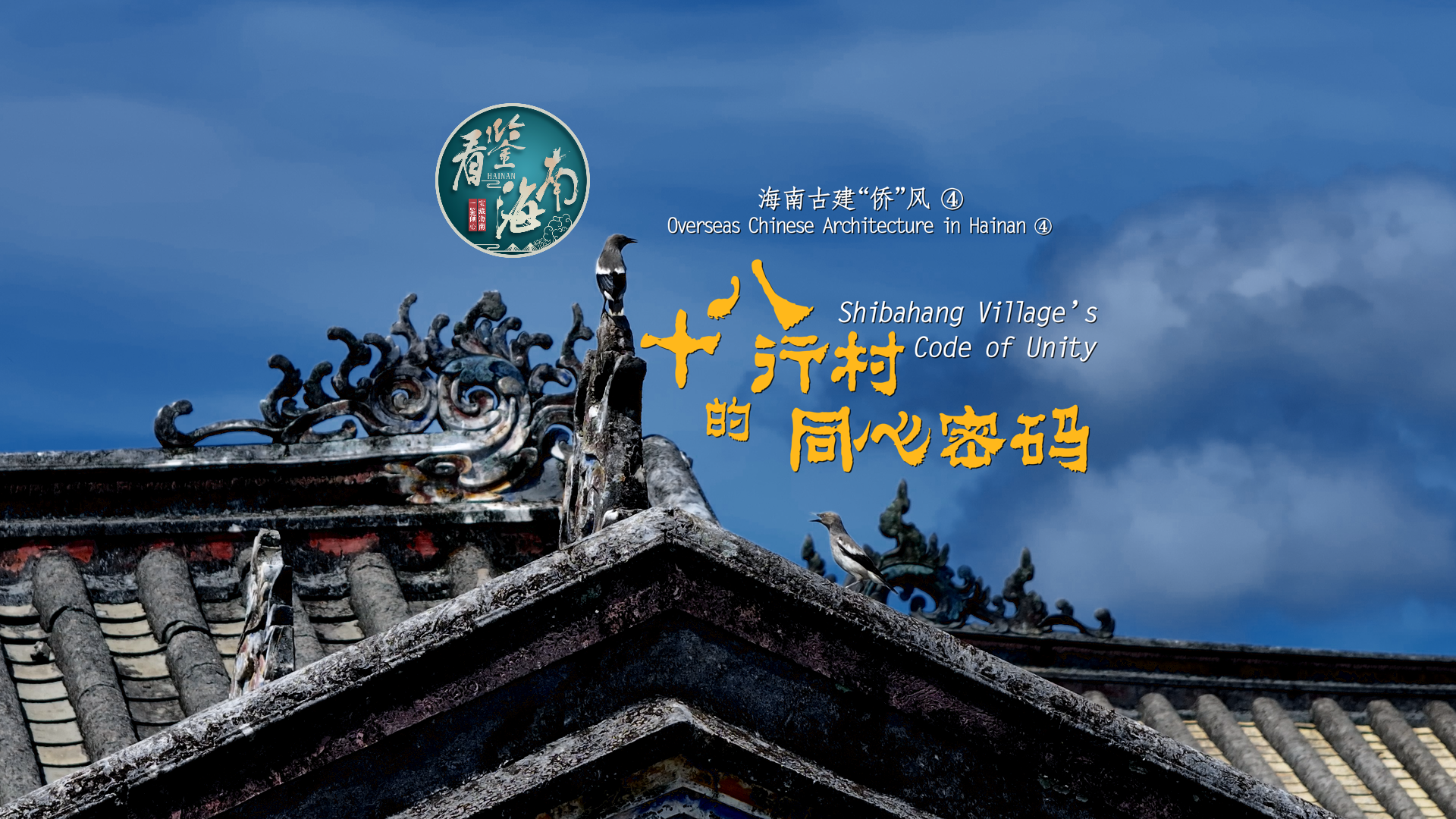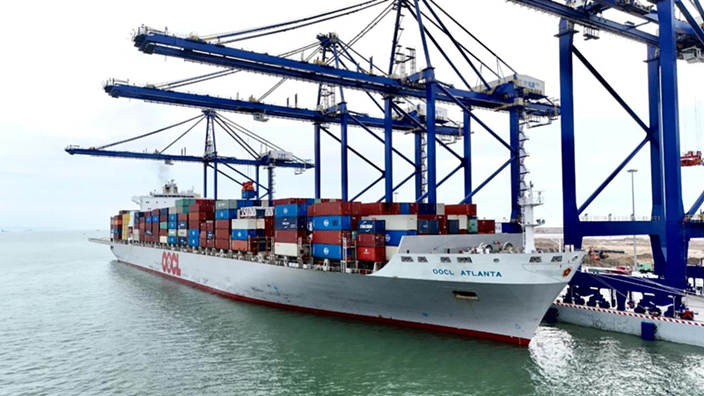
Many people say that the Hainan Coastal Scenic Highway is one of the island’s world-class projects. Not just a link connecting Hainan’s many wonderful attractions, it also brings together culture, food, and natural scenery. One of the highlights of the Haikou section of the Coastal Scenic Highway is the city’s distinctly Southeast Asian influenced historic downtown. This district has witnessed centuries of change from Haikou’s earliest beginnings as the fortified port in Hainan to the demolishing of the city walls and the paving of modern boulevards. The unique and distinctive architecture of Haikou’s Qilou Historic Quarter was—back in 2009—ranked with Beijing's Guozijian Street, Pingyao's South Avenue, and Fuzhou's Three Lanes and Seven Alleys as one of the first ten places in China to be recognized as a "Famous Historical and Cultural Street.”
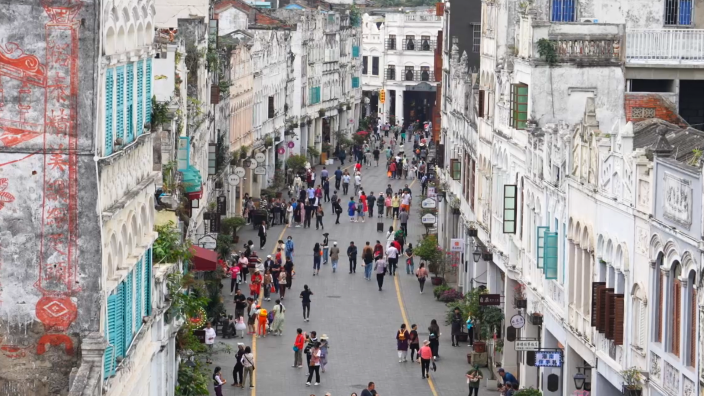
Birds-eye view of Haikou’s Qilou Historic Quarter. (Photo: Li Hao)
The ‘matriarch’ who gave birth to modern Haikou
Meng Lesheng, Haikou Federation of Social Sciences Deputy Chairman Emeritus, has a deep affection for the historic area. Per his introduction, the roughly 1.2km² of Qilou includes six major thoroughfares (Deshengsha, Zhongshan, Bo’ai, Xinhua, Jiefang, and Changdi) and four lanes (Jurenfang, Renhefang, Yuanneili, and Ximenwai) lined with over 600 three- and four-storey arcaded shophouses. In short, it is the birthplace of Haikou's urban civilization.
According to historical records, the streets and alleys of Haikou’s Qilou Historic Quarter have existed, more or less in their current configuration, for over 600 years. The key to the jade shores of Hainan and an important coastal defense area, the walled enclave at the mouth of the Nandu River played a positive role in promoting local development and stability. Early on in the Qing Dynasty (1644 - 1912), after other countries’ powerful ships and cannons broke open the isolation of the late Ming, this area became a thriving trading port and a place of commerce. An accident of geography quickly made this safe harbor a maritime trading port and resupply point for ships sailing between the southeast coast of China and Southeast Asia.
Strolling through the Qilou Historic Quarter, one’s eyes are met by row upon row of lovely arcaded shophouses to either side of the street. Creating a colonnade-style pedestrian walkway that provides passage while also sheltering people from the rain and sun, the upper levels of these usually three- or four-storey buildings extend out over the pedestrian walkway. Combining shopfronts, warehousing, family residences, and even courtyard gardens, these large buildings often extend as far back from the street as they do above it. Featuring highly figured balconies and terraces as well as the shaded colonnade-style pedestrian walkways that give the area its charm, the crisscrossing neighborhood streets that make up the Quarter are a mix of traditional local cultural characteristics with southern European architecture by way of southeast Asia.
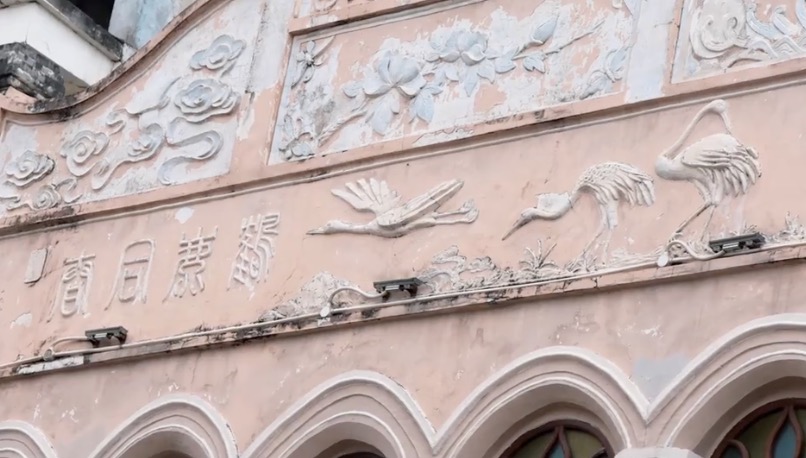
(Photo: Li Hao)
“Architecturally, these arcaded shophouses can trace their lineage back to the baroque period after the end of the Renaissance. Magnificent façades, delicate decorations, and elegantly sinuous lines, all hearken back to classical Western styles.” According to Mr. Meng’s introduction, the colonnaded arcades on both sides of the street acted to create not just a pedestrian walkway shaded from the sun, but also the perfect environment for commerce. Furthermore, they create a united front between buildings that give the streets a cleaner and more imposing look. Interconnected and accommodating, although these wide walkways predate modern urban planning regulations, the way in which they take all the shops on a single street and connect them into one large shopping space is nothing short of brilliant.
"We have to admire the wisdom and perseverance of the overseas Chinese merchants (especially those from Southeast Asia) whose work and persistent vision created such a huge district full of such beautiful buildings.” According to Mr. Meng, one of the oldest extant buildings in Haikou’s Qilou Historic Quarter is the magnificent Matsu Temple funded by 15th century scholar-official Wang Keyi. Starting out as a small trader on Beigang Island, Rao Xinxiao traveled back and forth to Nha Trang in Vietnam, building a commercial empire that at one point employed as many as 2,000 people and owned almost 20 cargo ships. His Yongle Theater—which now lives on in name only—was built in 1894 and put on performances of local Qiong Opera, Peking Opera, and even acrobatics shows. Other men whose vision and unremitting efforts left an indelible mark on the development history of Qilou include Wee Cheow Keng (Qiongshan native and eventual Director of Singapore’s Sze Hai Tong Bank) and He Daqi (a multinational shipping magnate originally from Qionghai).
From the moment the first arcaded shophouses were built in Haikou’s Qilou Historic Quarter, it became a humanistic commercial district with friendly architecture that not only protects customers from scorching sun and torrential tropical downpours but also serves the needs of merchants. Embracing the people like a kind ‘grandmother’, there is little wonder that it continues to thrive even in a modern era of air-conditioned malls.
The Artists of Qilou
Haikou’s Qilou Historic Quarter is known not only for its Southeast Asian streetscape, but also its flourishing traditional culture. Resident for generations, the craftsmen who call this place home are using their ingenuity and wisdom to preserve traditional arts and crafts, and protect the precious treasures of intangible cultural heritage.
Tucked away in a corner shop in the Qilou Historic Quarter, there’s a small charcoal painting studio—barely even 10m²—and appropriately named the “Home of Charcoal Paintings.” From portraits of people and paintings of flowers and birds hanging on the walls, the images are as realistic as photos. Belonging to Han Cuiqiong, who inherited the shop from her parents, all of the paintings currently for sale were done by her or her son Ye Baolong.
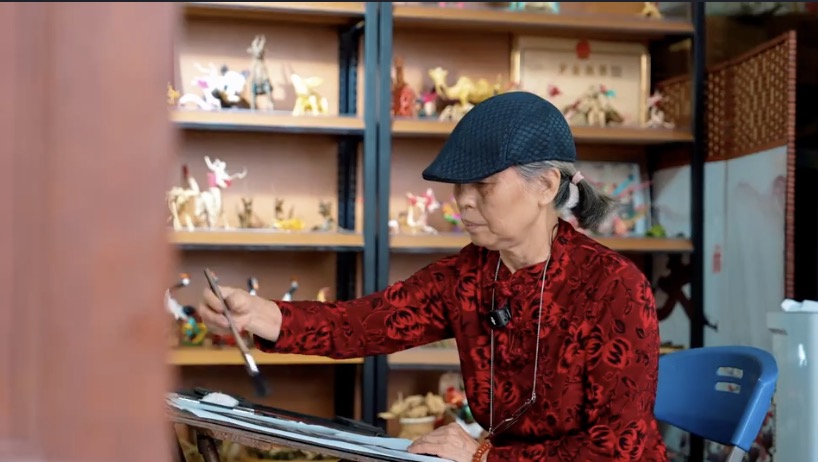
Charcoal Painting artist Han Cuiqiong at work. (Photo: Li Hao)
Charcoal Painting is a kind of Chinese folk art that uses powdered charcoal instead of colored paints or pencils. Primarily used as a portraiture method, it was inscribed on the provincial intangible cultural heritage list in 2007. Charcoal Painting began to gain popularity in Haikou in the 1940s. Charcoal Painting artists are a regular part of the daily streetscape on Xinhua and Zhongshan roads.
Originally from Wenchang’s Jinshan Town, Han Guanping—Han Cuiqiong's father—came to Haikou in search of his fortune when he was still a callow youth. While working at the Haikou Municipal Arts and Crafts Society, he engaged in self-study. After a few years, his painting skills—especially his Charcoal Paintings—had improved by leaps and bounds, and he opened his own studio as a sole proprietor. Winning admiration and recognition from locals and tourists alike, Han’s studio soon became one of the well known shops in the busy downtown area so much so that he was able to use his skills as an artist to support his whole family.
Deeply influenced by her father, Han Cuiqiong—who has loved painting ever since childhood—has a special place in her heart for Charcoal Painting. After she graduated from high school in 1972, she took over her father’ studio and became a second generation artist. After the Zhongshan Road was pedestrianized, Mrs. Han and her son moved their studio there.
"Immediately after it was closed to cars, Zhongshan Road became very quiet with very little business. Few people came. Now it is full of delicious things to eat and drink, wonderful activities, and interesting shops. I am glad to have witnessed the journey from obscurity to fame.” Over the years she has watched the Qilou Historic Quarter go from a chaotic backwater full of crumbling buildings to a neat and prosperous modern tourist area that is growing ever more popular.
More and more people are coming to visit Qilou. More people come into her studio asking questions, learning about local culture, and learning about Charcoal Painting. This brings Han Cuiqiong a great deal of happiness. “My roots are here. I will stay here forever." As she spoke, her brushstrokes gradually outlined and added detail to an initially rough form, and—offering a symbolic hope for the future of Home of Charcoal Paintings—a chance sunbeam lit up her paper and illuminated her hands.
Old Neighborhoods, New Concepts
Time flows like an inexorable river, and the "worldly flavor" of the arcaded shophouses has allowed them to send out runners and deeply take root in people's lives and hearts before they even realized it was happening.
Nowadays many of the old and newly rebuilt traditional-style buildings are home to all sorts of different types of modern businesses including classical teahouses, budget coffee shops, souvenir shops, western restaurants, and art galleries. During traditional festivals, the air is suffused with a sense of vitality and the neighborhood is home to a broad selection of activities such as intangible cultural heritage skills displays, opera performances, calligraphy and painting exhibitions, and lectures.
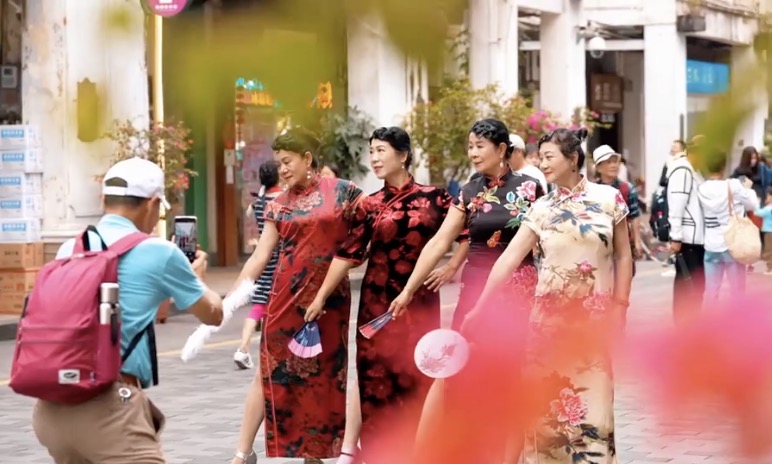
As of now, more and more new businesses are moving into the old buildings in Qilou and more and more tourists are visiting Haikou’s Qilou Historic Quarter. (Photo: Li Hao)
“Retaining their historical charm, these buildings somehow manage to seamlessly take in all kinds of emerging business formats.” The marine themed Vibe by the Sea gift shop near the entrance of Shuixiangkou Alley opened in May of last year and primarily sells local specialty foods and cultural and creative souvenirs. Store owner, Li Zi from Xiamen, Fujian, said it was no hard choice to decide to come here and open a souvenir shop. In addition to seeing the high cultural value of the area, the government's support and the ongoing construction of the Hainan Free Trade Port give her full of confidence in the future of Haikou.
"If we want to help bring the Qilou Historic Quarter to life, we need quality and innovation.” Mr. Meng is of the opinion that the rich and diverse historical and cultural relics accumulated on the old streets of Haikou’s Qilou Historic Quarter throughout its long history are what makes it attractive. As of right now, the important thing is doing a good job in the protection and repair of the old buildings, and in publicizing places like the Haikou Intangible Cultural Heritage Exhibition Hall and Art Gallery. At the same time, to make modern business take root here, it is necessary to incorporate a variety of new formats such as homestays, performances, and special food markets. Qilou’s unique and unmatched cultural IP is its ability to give tourists the chance to experience Southeast Asian customs and the opportunity to listen to the stories of the sons and daughters of Chinese descent who emigrated there.
Historic neighborhoods can be just as interesting and trendy as modern streetscapes. In Haikou’s Qilou Historic Quarter a cultural and tourism picture where “old” and “new” coexist is slowly unfolding.
Overseas Chinese Architecture in Hainan ④: Shibahang Village’s Code of Unity
05:47, 27-June-2025World Insect Week: Fantastic Flying Creatures in Hainan’s Rainforests
05:47, 27-June-2025Yangpu International Container Terminal Opens Direct Shipping Route to India
05:47, 27-June-2025It's time for Hainan "Village VA"!
03:13, 26-June-2025Surprise Delivery of Hainan Gifts!
03:13, 26-June-2025One invitation and they came to Hainan right away! Look, they are arriving!
03:12, 26-June-2025By continuing to browser our site and use the services you agree to our use of cookies, Privacy Policy and Terms of Use. You can change your cookie settings through your browser.
